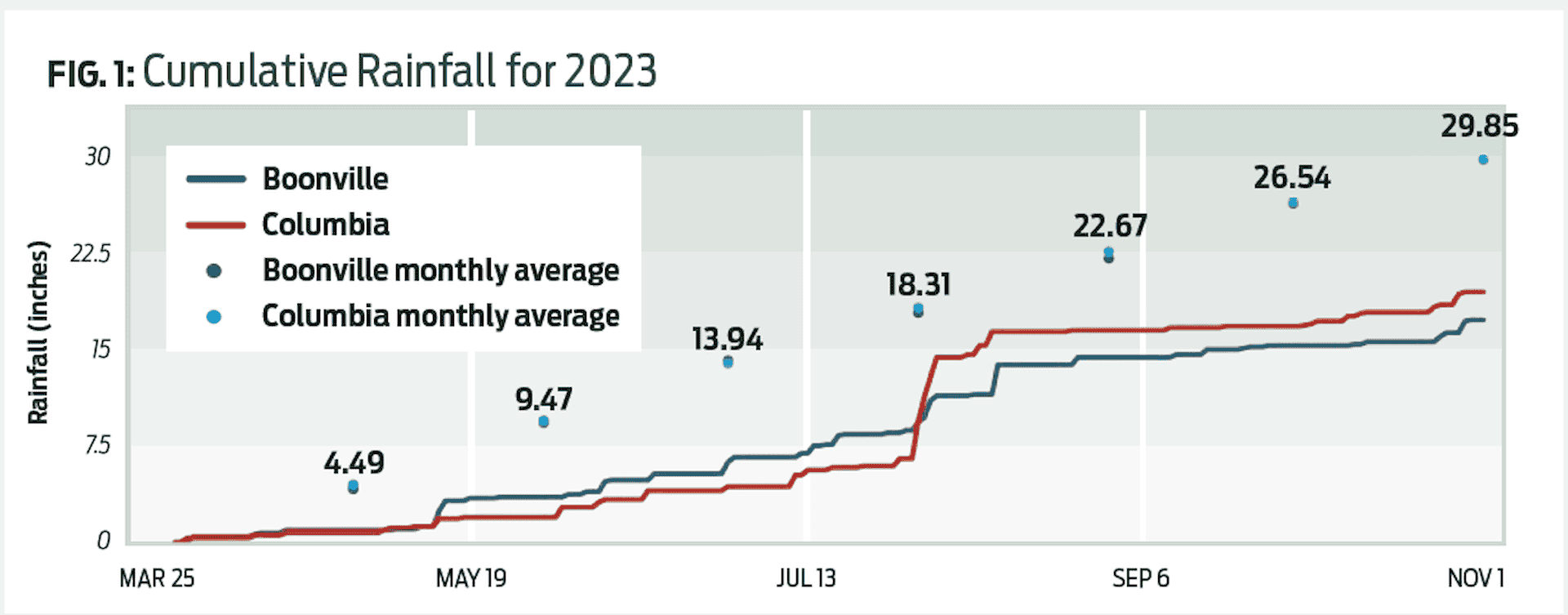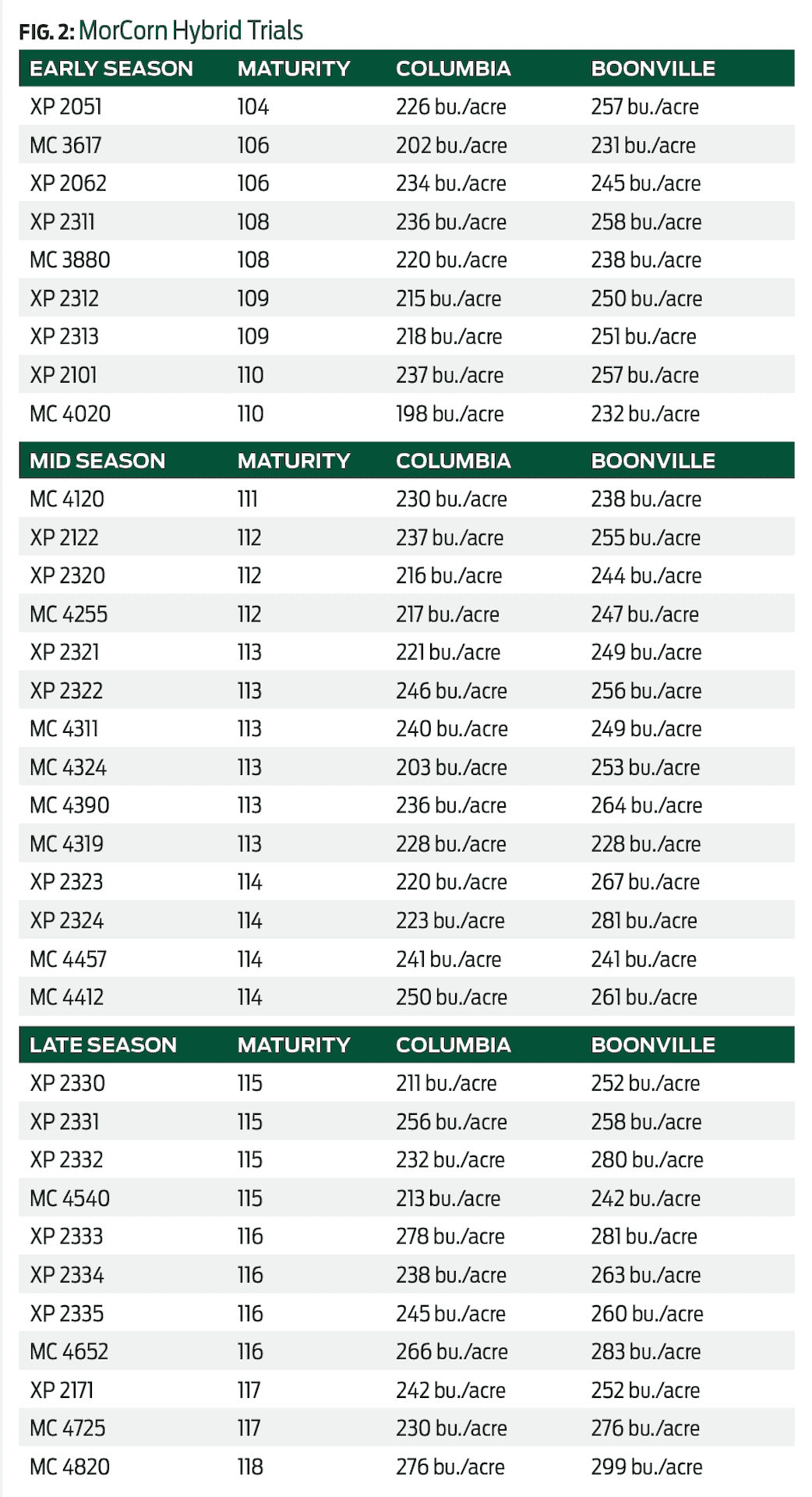Passing the test
MFA replicated trials advance new MorCorn hybrids, MorSoy varieties
By Garrett Imhoff, MFA research agronomist
Drier-than-average conditions in 2023 not only challenged growers but also MFA’s replicated trials.
Still, our MorCorn and MorSoy lineups had some remarkable yields on the farm and across the 14 locations where we test new seed products every year.
This article will focus on data collected from our research locations in Boonville and just east of Columbia, Mo., sites that represent both extremely productive and average growing conditions in our trade territory.
Both of these Central Missouri sites are on a corn-soybean rotation. In Boonville, corn plots were planted on April 18, 2023, at a population of 32,500 seeds per acre. The corn was fertilized with SuperU at planting with 300 pounds of actual nitrogen per acre. Since this is a testing location, we push nitrogen fertilization to eliminate the possibility of N being a limiting factor that affects yield. Soybeans were planted June 1 at a population of 140,000 seeds per acre. At this site in the Missouri River bottoms, the soil is well-drained silt loam.
At our site east of Columbia, corn was planted on May 23 at a population of 32,500 seeds per acre and fertilized with 180 pounds of actual nitrogen per acre with SuperU. Soybeans were planted on June 24 at a population of 140,000 seeds per acre. This is an average-yielding location situated on clay-pan soils that are poorly drained.
Site Weather
Last year’s weather made for easy planting but could not have started any drier, as illustrated in Figure 1. At both locations, precipitation was nearly 4 inches or more behind the average rainfall for the month of April. By the time we planted our plots, the margin had grown to nearly 6 inches behind the average. During the season, both locations struggled to grow with these challenging conditions. One saving rainfall to note came near the middle of July in Columbia to help push the corn through pollination.
While, for a majority of the season, both sites mirrored each other in rainfall, they began to differ in late summer. Rainfall deficits continued until late July when we received enough rainfall at Columbia to get within 4 inches of average. The same could not be said for Boonville. The rain helped to edge this site closer to average, but conditions continued to stay dry. As you can see from the rainfall chart, the drought only worsened in the fall.
The lack of moisture also reduced disease pressure at both locations. Along with genetics, this was a significant contributing factor in the yield performance of our plots.

MorCorn Hybrids
In the 2023 growing season, a total of 34 corn hybrids were tested across MFA territory. This number included 19 experimental products that were being considered as additions to the MorCorn line.
MC 4020 V is our new 110-day relative maturity hybrid. With an excellent agronomic package, it’s at the top of our list for tar spot tolerance as well as above-ground insect control, provided by the Viptera trait.
MC 4390 TRE was advanced to full production after impressive results in the testing cycle. This hybrid will replace MC 4311 TRE and MC 4319 VT2P as our premier 113-day relative maturity product. MC 4390 TRE not only offers a 6-bushel-per-acre yield advantage over MC 4311 TRE, but it also provides better tolerance for greensnap and drought, with the best performance seen on moderate to highly productive ground.
MC 4412 TRE has entered the MorCorn portfolio as a replacement for MC 4457 VT2P, offering a 9.4-bushel-per-acre average yield advantage in our trials. MC 4412 TRE provides consistent performance across various soil conditions, yielding above the maturity average in 13 out of 14 replicated sites, making it suitable for wide placement across our trade territory.
MC 4820 TRE was an impressive full-season product in the 2023 testing season, having the highest yield at our Boonville site and second overall across all 14 sites. MC 4820 TRE has great yield potential as a dual-purpose hybrid that fits best on moderate to highly productive ground.
With trials for the 2024 growing season now underway, we look forward to gathering yield data on 23 different experimental corn varieties from MFA’s trade territory.

MorSoy Varieties
In the 2023 growing season, MFA tested a total of 44 soybean varieties across our territory, including 22 experimental products being evaluated as possible additions to the MorSoy lineup.
One of those experimentals, XP 4038, was advanced into our portfolio as MS 3830 E. This variety proved its elite performance by outyielding every product tested in all our replicated trial sites. With the extreme drought conditions across our territory last summer, MS 3830 E not only packs a punch with high yields but also handles extreme stress throughout the growing season. MS 3830 E performs extremely well in high-yield environments but has a robust agronomic package to handle tough acres. MS 3830 E is the portfolio’s new performance leader, and we believe it has a place on nearly every farm.
XP 4040 was advanced into our lineup as MS 4000 E, MorSoy’s new Group 4 E3 variety. As an experimental variety, XP 4040 looked phenomenal throughout the season but especially stood out during drydown right before harvest. MS 4000 E is an excellent option for tough to moderate acres and is a direct replacement product for MS 4059 E. Not only does MS 4000 E have a 2-bushel yield advantage over MS 4059 E, but it also has improved agronomics, impressive standability, eye appeal and excellent performance for historically low-performing acres.
Our new 4.3 maturity E3 line is MS 4340 E, which we tested as XP 4043. This product showed strong performance and was a top yielder at our research site in Norborne, Mo., which has gumbo soils and experienced a stressful growing season. MS 4340 E is a perfect option for an early Group 4 E3 bean when a robust agronomic package is needed without sacrificing yield. MS 4340 E should perform well on all soil types in MFA’s trade territory.
Looking to the 2024 growing season, we will be gathering yield data on 23 different experimental soybean varieties at 21 different testing sites in our trade territory.

MORE - IN THIS AUGUST-SEPTEMBER ISSUE OF TODAY'S FARMER MAGAZINE - CLICK HERE.
View this article as printed in our Today's Farmer Magazine Flip book - CLICK HERE
Learn more about our seed selection here at MFA - CLICK HERE